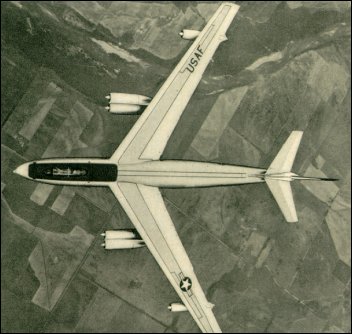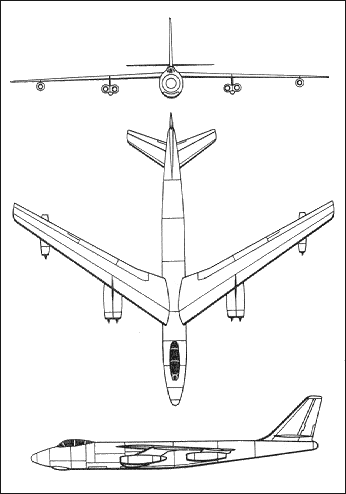 |
Boeing B-47 Stratojet1950 |  |
| BOMBER | Virtual Aircraft Museum / USA / Boeing |
 |
The B-47's production was spurred in 1944 by the War Department's demand for jet bombers. In contrast to the B-45, and other concurrent proposals, the B-47 design, as finally approved, included radically new features. Foremost were the aircraft's thin swept wings which, coupled with 6 externally mounted jet engines, promised a startling, high-speed bomber, probably capable of carrying out effective operations for the foreseeable future despite an enemy's fighter air defense. Undoubtedly, the B-47 lived up to expectations. More than 2,000 production models were bought, and some B-47 versions, true production models or post-production reconfigurations, remained in the operational inventory for nearly 2 decades. Yet few aircraft programs witnessed as much development, production, and post-production turbulence as the B-47 did. To begin with, there were arguments about cost and plant location and after 1947, complaints by Boeing that the newly independent Air Force had laid additional requirements that changed the concept of the overall program. Also, the secrecy which shrouded the development of atomic weapons, long after the atomic attacks on Japan, increased the difficulty of preparing the B-47 to handle every new type of special weapon-a problem shared by the B-36 and B-45. Ensuing events only compounded the initial disarray. As it had for the B-36, the Truman Administration's stringent financial restrictions worked in favor of the B-47. Pressed for money, the Air Force decided to buy more B-47s instead of purchasing additional B-50s or future B-54s, since neither one of those rather expensive bombers had any growth potential. Hence, even though the B-47 was yet to fly, the initial production order of 1948 was increased in mid-1949. The subsequent Korean War, rising world tensions, and mounting urgency to build an atomic deterrent force raised the tempo of the B-47 program. In December 1950, the Air Force foresaw a monthly production of 150 B-47s, but still recommended changes, making it almost impossible to settle on an acceptable type. Other factors made matters worse. The B-47 was the first USAF bomber to receive a weapon system designation, a move prompted by the Air Force recognition that the rising complexity of weapons no longer permitted the isolated and compartmented development of equipment and components which, when put together in a structural shell, formed an aircraft or missile. However, this was as far as the B-47 benefited from the new developmental philosophy. The Boeing air-frame was built without adequate consideration for its many crucial components. In turn, the components, subcontracted or furnished by the government, were behind schedule and when provided, did not match the sophistication of the high-performance B-47. In 1951 alone, the Air Force took delivery of 204 B-47Bs, none of which were suitable for combat. The aircraft's canopy was unsafe; the B-47B had no ejection seats (a deficiency shared by 200 successive B-47s); the bombing and navigation system was unreliable; a new tail defense system was needed; and the jet engines were creating unique development problems such as fuel boil-off at high altitudes, which reduced the aircraft's range-already shorter than anticipated. In sum, the hasty production of an aircraft as revolutionary as the B-47 proved to be costly, generating extensive, unavoidable modification projects like Baby Grand, Turn Around, High Noon, and Ebb Tide. Yet once accomplished, the B-47 modifications worked. Finally deployed overseas in mid-1953, the B-47s totally replaced the obsolete, atomic-carrier B-50s by the end of 1955, when new B-47 production models were delivered that could carry larger fuel loads and thus had greater range. After the B-47 demonstrated that it was rugged enough for low-altitude bombing, some of the aircraft were again modified to satisfy a new set of requirements levied in 1955. These modifications also worked, and in 1957, the Air Force publicly demonstrated its new low-altitude, strategic bombing tactics, an achievement marking the beginning of an era in aeronautics. Despite its convoluted start, the B-47 program proved successful. The aircraft served in various roles and was involved in many experimental projects, some connected to the development of more sophisticated atomic weapons, like Brass Ring, or with the development of air refueling or other endeavors of great significance to the Air Force. Strategic Air Command's last B-47s went into storage in early 1966, while a few converted B-47 bombers and reconnaissance models kept on paying their way for several more years, remaining on the Air Force rolls until the end of the 1960s. Boeing B-47 Stratojet on YOUTUBE
|  COMPANY PROFILE | |||||||||||||||||||||||||||||||||||||||||||||||||||||||||
 |

|

